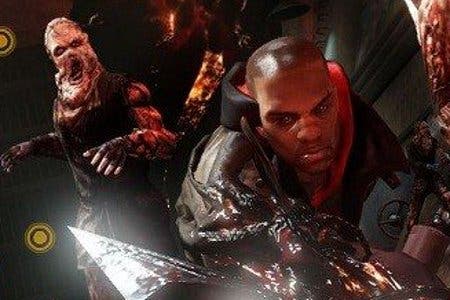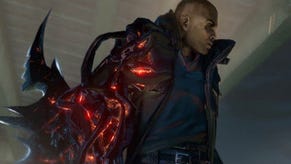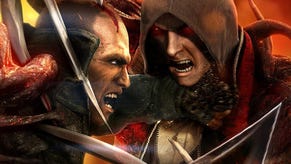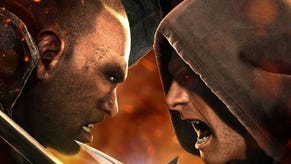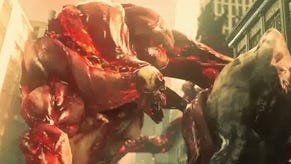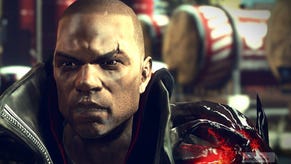Face-Off: Prototype 2
The Manhattan project.
| - | Xbox 360 | PlayStation 3 |
|---|---|---|
| Disc Size | 7.4GB | 12.4GB |
| Install | 7.4GB (optional) | 435MB |
| Surround Support | Dolby Digital | Dolby Digital, DTS, 5.1LPCM, 7.1LPCM |
Prototype 2 may not be Activision's biggest-selling franchise by any stretch, nor is it necessarily the most original pitch likely to have sounded through their corporate boardrooms. A sandbox superhero game based in an apocalyptic New York, where the end-game is to thwart a government conspiracy determined to experiment on its citizens? Lovely - why not? The narrative set-up is structurally sound; a safe, sturdy foundation to build on for the writers, while the tech side sees big improvements courtesy of the new Titanium Engine 2.0. Judging by the quality of the end result, it appears to have been worth the effort.
Much like the original game released in 2009, the big hook here is the explosive nature of battles, where the chaos intensifies as new powers, counters and movement upgrades are meted out. Every bit as dynamic and frenzied as those of Infamous and Crackdown, the game's action sequences often place you at the centre of a maelstrom of rocket-fire, projectile vehicles (by your doing most of the time) and a swarm of blindly panicking pedestrians - all of which typically rages on for as long as long as the mission lasts out. As mentioned in Christian's 7/10 Eurogamer review, this can be pretty exhausting for the player at times, and no doubt for the team optimising the engine for both 360 and PS3, who had to factor these peak stress points in from the start.
With the PC version sadly unavailable to us until mid-July, we take a close look at how the PS3 and 360 versions compare, between the image quality and performance. To kick off, let's start with a face-off video and our Prototype 2 720p comparison gallery. There's a respectably strong push towards console parity here, with many of the more obvious differences in the assets coming down to the variance in starting positions for pedestrian character models.
According to Prototype 2's design director, Matt Armstrong, the graphics engine of the first game has been overhauled to allow for a few nifty new tricks, including screen-space ambient occlusion (SSAO) and deferred lighting, which has a noticeable impact on the depth around minor details decorating the city. He also cites the number of objects and pedestrians permitted to be shown on-screen as a big area of improvement, alongside the implementation of superior tone mapping and particle effects.
The first Prototype's sub-HD viewing window of 1120x640 made for a blurry image overall, even when backed by its use of 2x multi-sampling anti-aliasing (MSAA), but here we're looking at a jump closer to a native resolution of 1200x672 on both PS3 and 360. What's more, this time the conventional multi-sample approach has been eschewed in favour of fast approximate anti aliasing (FXAA) on both versions - a post-processing technique that has recently grown in popularity due to its relatively low processing time and CPU costs.
The cost-effectiveness of FXAA when it comes to addressing aliased edges makes it a good choice for this sequel, but it's clear that the PS3's implementation of it manifests quite differently. For starters, it's plain to see that jaggies are cut down to a greater degree on Sony's platform, but the more aggressive processing to the image does have the knock-on effect of lightly softening texture work and high contrast details around the city. It's a difference that becomes very apparent when placing images of both versions side-by-side, and suggests that the algorithm used on PS3 isn't quite so refined.
Texture filtering has an edge on 360 too, but curiously, this version suffers to a greater degree from moire noise artefacting on building-sides and flooring. In effect, these appear as dark, semi-circular ripples over textures, cropping up most commonly over the "busier" tiles used for things like corrugated iron or brickwork. It's an issue on both consoles, with traces of the effect also in the exact same spots on PS3, but the more aggressive AA processing on that platform either eradicates it entirely, or dulls it to a point where it's no longer too glaring.
"Jaggies are cut down to a greater degree on Sony's platform, but the more aggressive processing does have the knock-on effect of lightly softening texture work and high contrast details around the city."

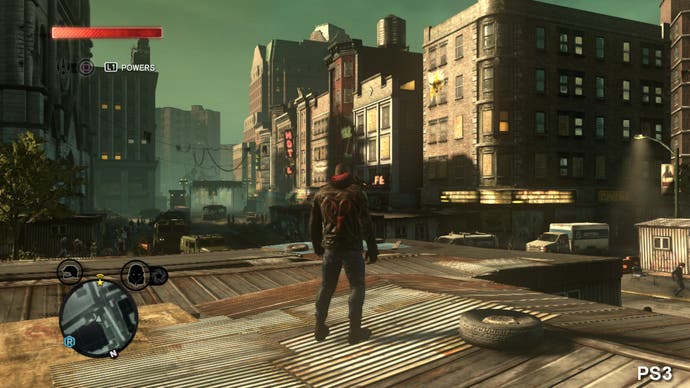
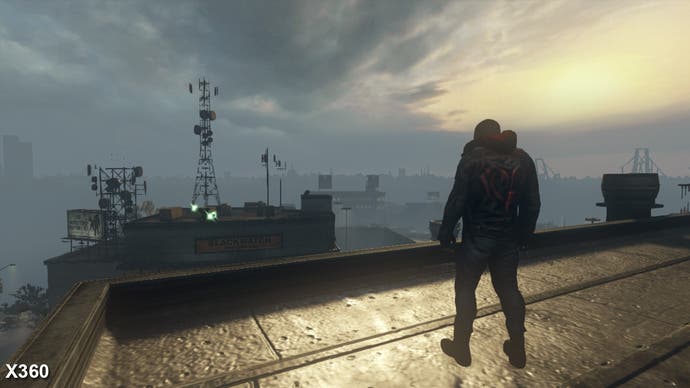
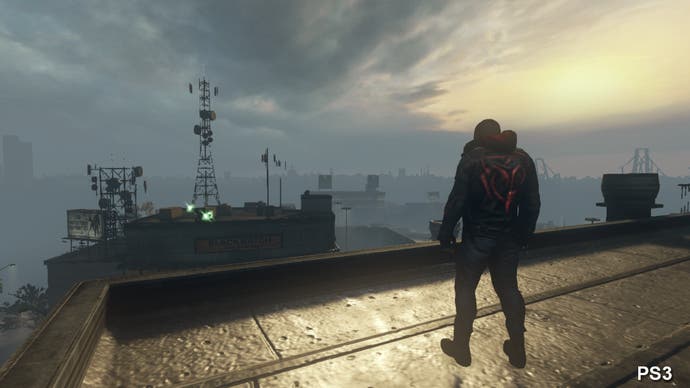
The city streets are swamped with an impressive civilian count - admittedly without too much of an agenda besides going ballistic whenever protagonist James Heller lifts a finger - and their density in numbers on the streets is practically like-for-like on both consoles. Ditto for objects and vehicles - an impressive feat given how many items in the environment can be manipulated by a Black Hole move unlocked early on, allowing you to draw anything in close proximity towards a target for an explosive finish. Tanks buckle and deform in a respectable number of stages, and buildings show cracked texturing in spots where you lumber up them - touches that all convincingly bring the superhero in Heller to life.
It looks the part then, but there are some weak spots. When the carnage begins to ramp up there are some elements which stand out as being sub-par by comparison to the rest of the visual make-up. In particular, the alpha effects used for explosions and gunfire stand out most. Resolution for these is unquestionably low on both platforms, which is perhaps to be expected given that a battle sequence can have any number of explosions or bullet trails on screen at once. The line had to be drawn somewhere, and we're glad it doesn't undercut the ability to have all these elements in play at once.
Otherwise, the lighting, shadowing (including the newly worked SSAO), and depth of field effects hold firm the visual style Radical is shooting for, and are ostensibly a match on both consoles. It's only minor variations in camera and character positioning that affect the pairing of some screenshots. The in-game cut-scenes are crudely utilised for simple "go here, do this" set-ups for the next mission - usually infiltration - but it's the video cinematics which ultimately end up pushing the narrative forward.
"When the carnage begins to ramp up there are some effects which stand out as being sub-par in comparison to the rest of the visual make-up, such as explosions and gunfire."

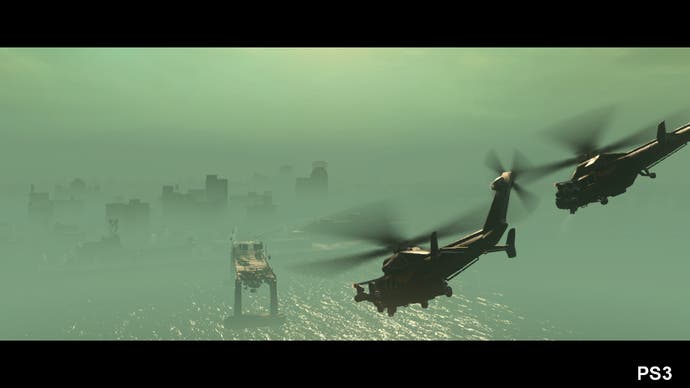
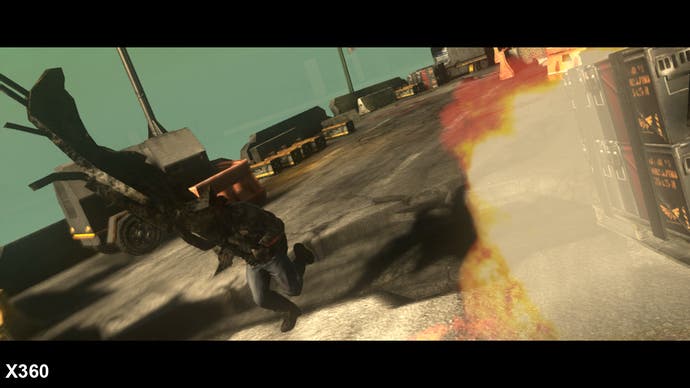
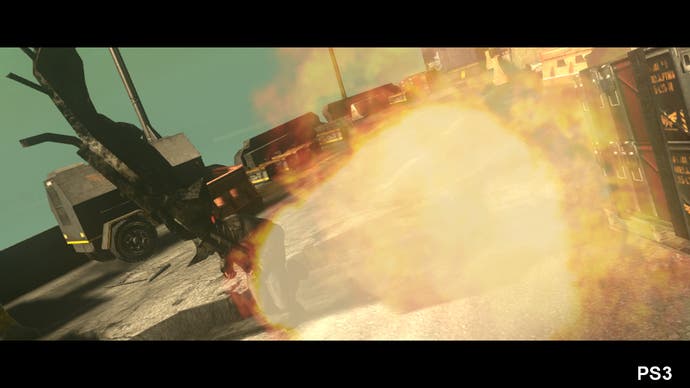
The use of pre-rendered footage strikes us as a disappointment in terms of preserving the game's visual consistency. There's a blatant disconnect between the stylisation used in-game, and the black, white and red motif used across all the FMVs that could have easily been avoided. As a result, transitions feel abrupt, and are made all the more jarring by the way character designs appear different enough from their in-game models to sometimes make you question who they are. In the end, these feel like they were handled by two completely separate departments with no unified artistic direction.
Performance Analysis
Moving on to performance, it appears that widening the draw distance over the first game forms the root cause for some frame-rate issues on both consoles. This is despite the way its draw limitations are already disguised by a thick veil of fog over the far distance, which, given that Heller spends much of the time gliding from rooftop to rooftop with a full panoramic view as an option, tends to be a pretty regular sight indeed.
The target frame rate is 30FPS - although jumping from a high point and gliding across the more central, heavily populated roads of New York City is a very easy way to drag that down to 25FPS on both HD consoles. It's not in equal measure at every point, but overall the PS3 does offer a noticeably smoother level of performance in like-for-like scenarios, such as cut-scenes and travel, and crucially manages to achieve this with v-sync permanently engaged.
"Widening the draw distance over the first game forms the root cause for some frame-rate issues on both consoles, despite the way its draw limitations are already disguised by a veil of fog over the distance."
On the other hand, although v-sync is thankfully engaged during in-game cut-scenes, torn frames appear in long clusters during gameplay on 360. This isn't restricted to the upper 10 per cent overscan area of most HDTVs either, but instead runs down its entire height and chops the screen in half for long spells of play, and can be particularly distracting. This at least keeps the game's refresh up to relatively playable speeds, but is far from ideal for the IQ purist, and the performance gains are rarely enough to match the smoother output on Sony's console.
Of course, both formats can hold their 30FPS promise while indoors during infiltration missions, or even in narrow street areas with plenty of large, colluding objects to hide distant geometry. Boss fights in science facilities don't pose a problem either, but picking a fight with a Blackwatch post while swooping and diving overhead is a sure-fire way to bring that frame-rate down again. It's often the overload of alpha effects from bazooka fire that proves a bit of a struggle for both sides of the hardware fence, and can be exacerbated by the hordes of pedestrians flitting about the area.
The very lowest we see the frame rate go is when - perhaps inevitably - we start to involve the big guns: the tanks, the helicopters, the summoned fiends you unlock later on. They're all the prime culprits, and with these in your arsenal, you can have whole missions go by where neither console gets close to their target frame-rate, lingering under 25FPS. There aren't many sandbox-style games on console which play out in their entirety without some hitch or another, but the level of freedom Prototype 2 gives a player during these moments does have us looking up the PC release date, and wondering "what if?"
"With a lot going on, whole missions play out at a sub-optimal frame-rate. During these moments, you can't help but look up the PC release date and wonder... what if?"
Prototype 2: The Digital Foundry Verdict
In review, Prototype 2 is an entertaining ride, but those wanting to play the game at its very best will have to wait another three months for the PC release. As it stands right now though, it's the PS3 version that comes recommended without much reservation. It simply plays out better overall during combat and travel alike, and considering it offers the same basic assets and rendering techniques as the 360 version, albeit minus the incessant tearing, it can often end up looking better in motion too.
The only detracting point for PS3 is the more aggressive implementation of its FXAA post processing, which faintly softens some of the detailing on textures. Incidentally, this does a good job of covering up the anisotropic noise left behind on 'busy' wall textures - a blemish that remains conspicuous on 360 with its slightly sharper image. As far as technical proficiency goes, however, every other facet of the game is of matching quality on both formats, from the reworked lighting to the implementation of SSAO, which is to be commended.
Prototype 2 can and can't do certain things. It can't claim to redefine the sandbox action genre, but it does a fine job of carving out its niche as a comic-book superhero game. It can easily identify itself as a wild, guilty pleasure; an extravagant, high-octane romp with camp B-movie dialogue that might qualify it for cult affection somewhere down the line. Titanium Engine 2.0 can also claim to be a respectable foundation to build this kind of experience around too, although we'd hope the next iteration takes a similarly revisionist approach, and pushes the optimisations even further for Prototype 3. But of course, by that time we may well already be tucking into the next generation of consoles anyway...
